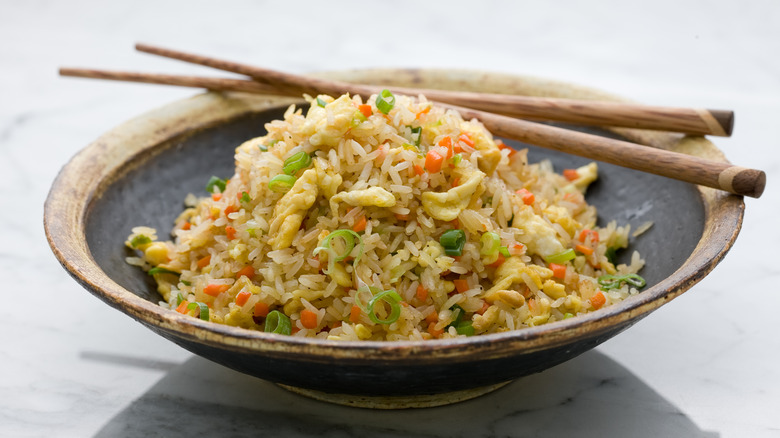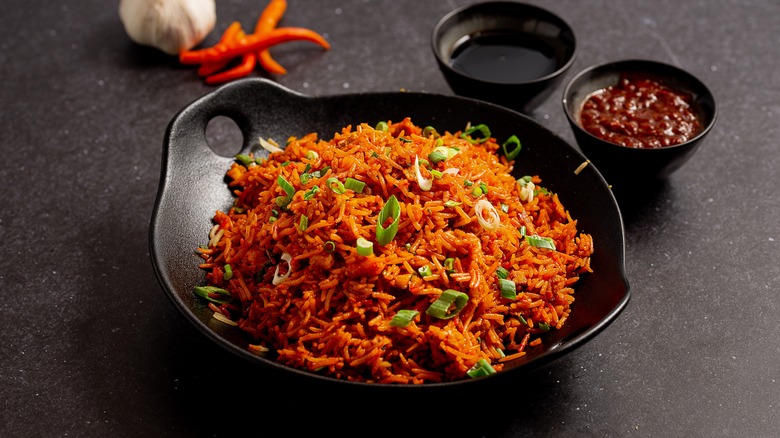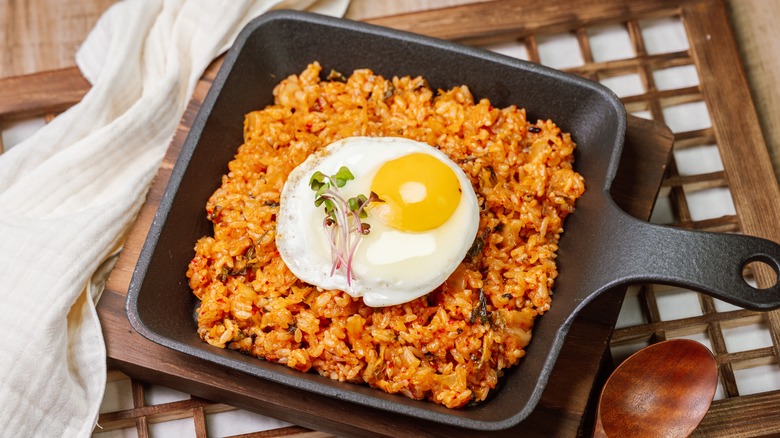Korean Vs Chinese Fried Rice: What's The Difference?
Whether you're using it as a complementary side dish or as the main event of your meal, fried rice is a classic Asian culinary staple. Scholars believe the original recipe came from Yangzhou, China during the Sui Dynasty (581 to 618 CE). At this time, it was loved by Emperor Yang and peasants alike, who would make it as a way to use leftover scraps such as day-old rice, proteins, vegetables, and eggs. These were all fried in stages in a wok then seasoned with salt, soy sauce, or oyster sauce. Over time, fried rice made its way around the continent and eventually the world, evolving based on each country's individual flavors and local ingredients.
While all versions have a similar base, the specifics of fried rice vary from country to country. For example, Thai fried rice is made with jasmine rice and incorporates the region's bold flavors such as hot chili peppers and lime, while Indian fried rice includes spices like cumin and turmeric. Chinese fried rice differs from Japanese fried rice in flavor and texture, with Japanese additions of dried seaweed and dried tuna flakes. Similarly, the differences between Chinese and Korean fried rice come down to specific varieties of rice and the ingredients that get mixed in.
What is Chinese fried rice?
Because fried rice first appeared in China, it's imperative to look at the original. Yangzhou fried rice, named after the eastern city where it started, is made with long-grain rice because it is less sticky than short-grain rice and therefore fries better. Another aspect that helps this rice fry easily is that it's drier because it gets cooked at least one day in advance (as the dish began as a way to use up leftovers). The rice is tossed with ingredients such as chicken, Chinese ham, scallops, shrimp, bamboo shoots, peas, and sea cucumbers.
China is a large country, so naturally there is more than one style of Chinese fried rice. Southern Cantonese fried rice has a lighter flavor and Sichuan fried rice takes on the spicer ingredients of western Sichuan cooking, such as chili and Sichuan peppers. Regardless of the region, at events such as Chinese New Year, funerals, and weddings, fried rice is served at the end of the meal for two reasons: Practically, it ensures that nobody leaves hungry, and symbolically, it is believed to bring longevity to the lives of those who are dining.
What is Korean fried rice?
The major element that sets Korean fried rice apart from the Chinese versions is the rice itself. While the Chinese recipes call for day-old, dried-out, long-grain rice, Korean fried rice is made with short-grain rice, which is starchier. This type of rice takes longer to absorb the oil, resulting in a more risotto-like dish. Often, a more flavorful oil such as sesame will be used to fry the rice.
There are many essential ingredients for Korean cooking, including scallions, radishes, pork belly, ganjang (a saltier soy sauce), and kimchi (or fermented cabbage). Any of these ingredients make for an excellent addition to a Korean fried rice dish, like in this kimchi fried rice with fried eggs on top. Oftentimes, Korean fried rice is made using the leftover ingredients from the meal made that day, which are left in the pan then fried with the rice. Like in China, this version is served at the end of the meal, as well. If there is an abundance of extra sauce leftover from whatever dish was made that day, sometimes scorched rice, or the caramelized rice left at the bottom of the pan, will be mixed with the sauce and served as a final dish, too.


